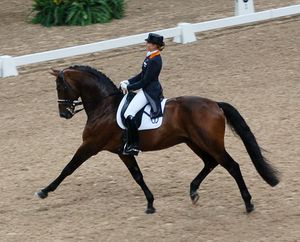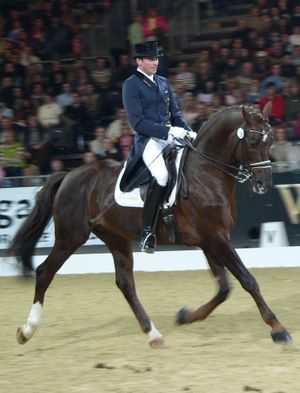ترويض الخيول
 An upper-level dressage competitor performing a working trot | |
| أعلى هيئة حاكمة | International Federation for Equestrian Sports (FEI) |
|---|---|
| السمات | |
| التلامس | No |
| أعضاء الفريق | Individual and team at international levels |
| من الجنسين | Yes |
| المعدات | Horse, appropriate horse tack |
| مكان اللقاء | Arena, indoor or outdoor |
| الحضور | |
| البلد أو المنطقة | Worldwide |
| أولمپية | 1912 |
| الأولمپية الخاصة | 1996 |
ترويض الخيول (Dressage ؛ /ˈdrɛsɑːʒ/ أو /dr[invalid input: 'ɨ']ˈsɑːʒ/; مصطلح فرنسي يشير عادة إلى معنى "تدريب") هي إحدى رياضات الفروسية التنافسية, يعرّفها الاتحاد الدولي للفروسية بأنها "تمثل أسمى تعبير عن تدريب الخيول", حيث "يُتوقع أن يؤدي كل من الفارس والحصان سلسلة من التحركات المحددة مسبقًا والمحفوظة في الذاكرة "[1] وتُقام المنافسات في كل المستويات من الهواة وحتى بطولة ألعاب الفروسية العالمية. تهدف هذه المسابقات من خلال أساليب التدريب المتقدمة إلى تطوير القدرة الرياضية الطبيعية لدى الحصان واستعداده للأداء، بحيث يحقق أعلى مستوى أداء حصان سباق. وفي قمة تطور الأداء الترويضي للحصان، سيستجيب الحصان بمرونة فائقة إلى حركات المساعدة البسيطة من الفارس الماهر. وسيبدو الفارس في هذه المسابقات وكأنه لا يبذل أي مجهود بل ومسترخ تمامًا بينما يقوم الحصان تلقائيًا بأداء التحركات المطلوبة. ويشار إلى رياضة ترويض الخيول أيضًا باسم "باليه الخيول". وعلى الرغم من أن جذور تلك الرياضة تعود إلى قارة أوروبا، فإن ترويض الخيول اعتُرف به للمرة الأولى كرياضة مهمة من رياضات الخيول في أثناء عصر النهضة. وطور الفرسان الرواد الأوروبيون في تلك الفترة منظومة تدريبية تتابعية لم يطرأ عليها تغييرات كبرى لاحقًا. ولا يزال ترويض الخيول الكلاسيكي أساس رياضة ترويض الخيول الحديثة.
في مسابقات ترويض الخيول الحديثة, يبرهن الفارس على مدى قدرته على التدريب في كل المستويات من خلال أداء "الاختبارات"، وهي عبارة عن مجموعة محددة من التحركات التي ينبغي أن يؤديها الحصان في حدود مساحة معينة. يقيّم الحكام كل حركة على أساس معيار موضوعي مناسب لمستوى الاختبار ويعطون لكل حركة درجة من مقياس من صفر إلى عشرة – حيث يشير الصفر إلى أن الحركة "لم تُؤد من الأساس" بينما يحصل الفارس الذي يؤدي الحركة بشكل "ممتاز" على الدرجات العشر كاملة. وتشير النقاط التسع إلى أن الحركة كانت جيدة للغاية وتعد درجة عالية، بينما يحق للمتسابق الذي يحقق ست درجات (أو 60% إجمالاً) أن ينتقل إلى المستوى التالي.
انظر أيضًا
ملاحظات
- ^ About Dressage, International Equestrian Federation, retrieved August 26, 2011 Archived 2017-10-02 at the Wayback Machine
المراجع
- Burns, T. E. & Clayton, H. M. (1997) "Comparison of the temporal kinematics of the canter pirouette and collected canter". Equine Veterinary Journal Supplement; 23, 58–61.
- Blackfern (2005) Printable Arena Diagram
- Barretto de Souza, Joseph, Count (c. 1927) Elementary Equitation and Advanced Equitation. New York: E. P. Dutton & Co /London: John Murray
- Clayton, H. M. (1997). "Classification of collected trot, passage and piaffe using stance phase temporal variables". Equine Veterinary Journal Supplement. 23 (23): 54–57. doi:10.1111/j.2042-3306.1997.tb05054.x. PMID 9354290.
- Clayton, H. M. (1995). "Comparison of the stride kinematics of the collected, medium, and extended walks in horses". American Journal of Veterinary Research. 56 (7): 849–52. PMID 7574149.
- Clayton, H. M. (1994). "Comparison of the stride kinematics of the collected, working, medium, and extended trot". Equine Veterinary Journal. 26 (3): 230–34. doi:10.1111/j.2042-3306.1994.tb04375.x. PMID 8542844.
- Clayton, H. M. (1994). "Comparison of the collected, working, medium, and extended canters". Equine Veterinary Journal Supplement. 17: 16–19.
- German National Equestrian Federation (1990) The Principles of Riding. Boonsboro, Md: Half Halt Pr.
- Advanced Techniques of Riding (1987) (Official Handbook of the German National Equestrian Federation) English edition, Boonsboro, Md: Half Halt Press.
- Herbermann, Erik (1993). Dressage Formula. London: J. A. Allen & Co.
- McNeil, H (2011)40 Fundamentals of English Riding. North Adams, MA: Storey, ISBN 978-1-60342-789-0
- Minetti, A. (1998) "The biomechanics of skipping gaits: a third locomotion paradigm?" Proceedings of the Royal Society of London: part B, 265(1402): 1227–35.
- Museler, Wilhelm Riding Logic. New York: Simon & Schuster, ISBN 0-671-76492-6 (translation first published: London: Methuen, 1937; many later editions)
- Santini, Piero (1936) The Forward Impulse. London: Country Life
- Wynmalen, Henry (1953) Dressage: a study of the finer points of riding. London: Museum Press
- (also, by the same author, Equitation. London: Country Life, 1938)
